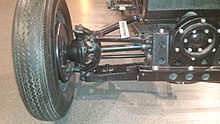Steering knuckle
The steering knuckle refers to the wheel carriers which can be pivoted about an almost vertical axis in the stub axle steering .
Types and their development
The invention of the stub axle steering meant that the outer, wheel-bearing parts were no longer firmly attached to the front - still common at the time - rigid axle , but pivoted to it. The stub axle steering is the further development of the turntable steering and is only used in automobiles .

Horch Museum in Zwickau
Rigid axles
For non-driven axles, the respective stub axle received a connection part, into which a joint pin ( kingpin ) was inserted to establish the connection to the rigid axle (see picture above). The corresponding connection part of the rigid axle was mainly fist-shaped (one-piece, fist axle ), that of the stub axle fork-shaped (two-part). The reversal of the joint element was less common: the shape of a fist on the steering knuckle ↔ the shape of a fork on the fork axis (see figure on the right).
For driven axles, the drive had to be guided through the pivot joint of the drive axle to the wheel hub . The fork axle was used as the rigid axle . The kingpin became two bolts (one for the upper and one for the lower bearing part). The connection piece on the steering knuckle was also forked.
A reversal of the joint element took place during the bearing of the wheel hub: the wheel hub is no longer supported by roller bearings on an axle stub, but in a sleeve-like part of the connection piece. The pin of the hub used for bearing is hollow for the connection to the drive shaft (torque transmission by means of splines ).
Independent suspensions
The transition to ball joints between the handlebars and the wheel carrier (see figure on the right for the Formula Vee front axle) shows the development of modern wheel suspensions. The steering axis is no longer given by a material component (kingpin), but by the connection of the two ball joints. This development continues through the breakdown of the lower link level into individual rod links to the virtual spread axis , in which one of the two points that determine the steering axis is immaterial. In this way, the scrub radius and the impact radius can also remain small for the larger space required for the disc brake due to increasing engine power . The term steering knuckle is replaced by the more general term wheel carrier.
Further connection points on the steering knuckle
In addition to bearing points for the pivoting wheel suspension , the connecting piece of the steering knuckle also contains fastening points
- * for the articulated connection with the tie rod and
- * for the brake caliper for disc brakes or for the anchor plate for drum brakes .
literature
- Bernd Hoting, Metin Ersoy, Stefan Gies: Chassis Manual . 4th edition, Springer Vieweg Verlag, 2013, ISBN 978-3-658-01991-4 .
- Wolfgang Matschinsky: Wheel guides of road vehicles: kinematics, elasto-kinematics and construction. 3rd edition, Springer Verlag, Berlin / Heidelberg 2007, ISBN 978-3-540-71196-4 .
Individual evidence
- ↑ Bernd Heißing et al.: Chassis manual . 2013, p. 366.
- ↑ kfz-tech.de - Lexicon: "Steering knuckle: The parts of the wheel suspension that swivel when steering." Kfz-tech.de
- ↑ a b kfz-tech.de - Lexicon: “the axle body that ends in a fist” kfz-tech.de
- ↑ Steering knuckle with two steering bearing bushes in the "steering knuckle fork" (2), connected to the "axle fist" (5) by means of a kingpin. citwiki.de ( Memento from January 27, 2016 in the Internet Archive )
- ↑ a b Johannes Volmer : Gear technology. Vieweg, 1978, p. 58.
- ↑ Steering knuckle of a driven wheel (above: connection piece with sleeve for mounting the wheel hub; right: wheel hub; roller bearing not shown). data.motor-talk.de
- ↑ This point is instantaneous , which on the vehicle outer side of the brake disc may be, while the outer guide of the joint unresolved wishbone on the inner side must remain. See Wolfgang Matschinsky. Wheel guides for road vehicles. Springer, 2007, p. 396.


